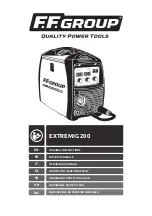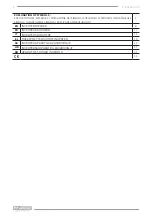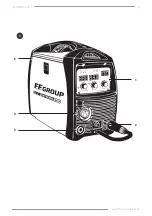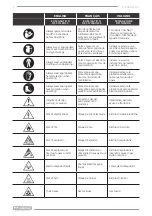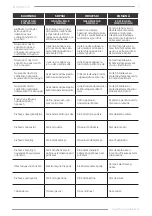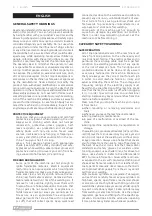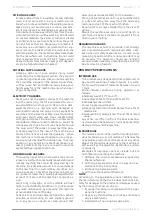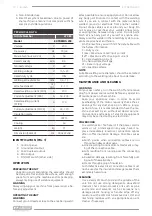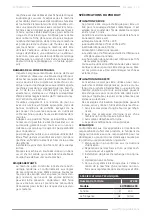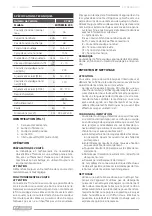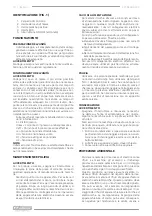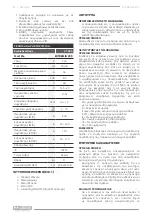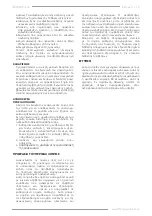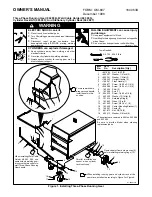
| English
8
ENGLISH
GENERAL SAFETY WARNINGS
Read and understand this owner’s manual before op
-
erating this product. You can help prevent accidents
by being familiar with your product’s controls and by
observing safe operating procedures and safety signs.
Always use your common sense to avoid all situations
considered beyond your capability. Do not use while
you are tired or under the influence of drugs, alcohol
or any other medication. Keep bystanders and animals
that could be hurt, as well as items that could be dam
-
aged away, while operating. Never allow children or
people unfamiliar with these instructions to use the
product. Local laws may restrict the minimum age of
the operator. Bear in mind that the operator or user
is responsible for accidents or unexpected events oc-
curring to other people, animals or their property. Do
not expose the product to excessive moisture, dust,
dirt or corrosive vapors. Do not mount equipment or
accessories on the machine not foreseen or approved
by the manufacturer. Never attempt to modify the
product. Non-authorized modifications or accessories
can result in serious personal injury or the death of the
operator or others. Consult your authorized dealer for
disassembly and service, not covered in this manual. If
something breaks or an accident occurs while working,
turn off the machine immediately and move it away to
prevent further damage. In case foreign body has en-
tered the machine, stop it immediately, inspect it for
any damage and make repairs before starting it again.
PROTECTIVE EQUIPMENT
Make sure that you use appropriate and certified
protective equipment when operating the unit.
Always wear clothing which does not hamper
movements, protective gloves, goggles, half-
mask respirator, ear protection and anti-shear
safety boots with non–slip soles. Never wear
scarves, necklaces or any hanging or flapping ac-
cessory and clothing that could catch in the ma-
chine. Tie up your hair if it is long.
Wear a full coverage helmet with appropriate
shade (see ANSI Z87.1 safety standard) and safe
-
ty glasses while welding. Wear proper gloves and
protective clothing to prevent your skin from be
-
ing exposed to hot metals, UV and IR rays.
FIRE AND BURN HAZARDS
Some parts of the machine get hot enough to
ignite flammable materials. Electric equipment
malfunctions can cause sparks which could ignite
flammable material. Make sure that you keep your
work area clean and tidy and do not use the ma
-
chine near flammable material. Remove all flam
-
mable materials within 10m of the welding arc. If
removal is not possible, tightly cover them with
fireproof covers. Take precautions to ensure that
flying sparks do not cause fires or explosions in
hidden areas, cracks or areas you cannot see. If a
fire occurs, use an appropriate fire extinguisher.
Wear garments that are oil-free with no pockets
or cuffs that will collect sparks. Keep work lead
connected as close to the weld area as possible to
prevent any unknown, unintended paths of elec
-
trical current from causing electrical shock and
fire hazards. To prevent any unintended arcs, cut
wire back to ¼" stick out after welding.
Some parts of the machine get hot enough to
cause burn damage. Pay attention not to touch
them in order to avoid getting burned. Let the
machine cool before storing it.
CATEGORY SAFETY WARNINGS
SAFE OPERATION
All of the operational levers of the machine must
move from one position to the other easily and
must not need forcing. The electric cables and in
particular the main plug cable must be in perfect
condition to avoid the generation of any sparks
or the risk of electric shock. The handgrips and
protection devices must be clean and dry as well
as securely fastened to the machine. Make sure
that you always use the correct tool for each job
in order to avoid machine failure or injury and
avoid overloading the machine. The voltage and
frequency ratings of the electricity supply must
be within the specifications of the machine. Make
sure that the machine switch is off when plugging
it in, in order to avoid risk due to unintentional
starting. Remove any keys and wrenches from the
machine before operating.
Make sure that you stop the machine and unplug
it from mains:
f
When mounting or removing accessories and
tools.
f
Whenever you leave the machine unattended.
f
During cleaning or maintenance.
f
In case of a malfunction or overload of the ma
-
chine.
f
During machine repositioning, transportation or
storage.
The welding arc produces ultraviolet (UV) and infra
-
red (IR) rays that can cause injury to your eyes and
skin. Do not look at the welding arc without prop
-
er eye protection. Always use a helmet that covers
your full face from the neck to top of head and to
the back of each ear. Use a lens that meets ANSI
standards and safety glasses. For welders under
160 Amps output, use a shade 10 lens; for above 160
Amps, use a shade 12. Refer to the ANSI standard
Z87.1 for more information. Cover all bare skin are
-
as exposed to the arc with protective clothing and
shoes. Wear flame-retardant cloth or leather shirts,
coats, pants or coveralls. Use screens or other barri
-
ers to protect other people from the arc rays emit
-
ted from your welding.
High pressure cylinders can explode if damaged,
so treat them carefully. Never expose cylinders to
high heat, sparks, open flames, mechanical shocks
or arcs. Do not touch cylinder with MIG gun. Do not
weld on the cylinder. Always secure cylinder upright
to a cart or stationary object. Keep cylinders away
from welding or electrical circuits. Use the proper
regulators, gas hose and fittings for the specific ap
-
plication. Do not look into the valve when opening
it. Use protective cylinder cap whenever possible.
EXTREMIG 200

